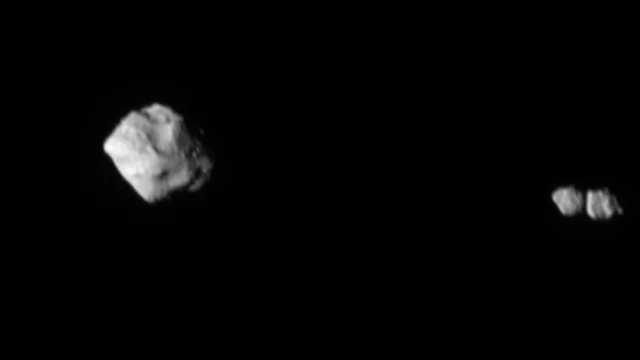The first look at the Dinkinesh asteroid revealed a surprise: The small space rock had its own moon. Now as the Lucy spacecraft downlinked more images of its first target, it showed not one but two tiny asteroids orbiting around Dinkinesh.
NASA’s Lucy mission made a close flyby of the Dinkinesh asteroid on November 1, capturing data about the rocky object in the main asteroid belt. As it turns out, this small little guy was hiding a big secret: a tiny moon. But that’s not the only surprise; Dinkinesh is no ordinary binary system—it hosts a satellite that’s a contact binary consisting of two smaller objects in direct contact, NASA announced on Tuesday. The surprise space rocks are the first contact binary orbiting asteroid to ever be observed.
“Contact binaries seem to be fairly common in the solar system,” John Spencer, Lucy deputy project scientist at the Southwest Research Institute, said in a statement. “We haven’t seen many up-close, and we’ve never seen one orbiting another asteroid.”
In the first images that Lucy downlinked to mission teams on the ground, the two lobes of the contact binary asteroid appeared as one from the spacecraft’s point of view. As the spacecraft flew further away from the asteroid system, it became clear that these were actually two space rocks touching each other while in orbit around Dinkinesh.

At its closest approach, Lucy captured its first set of images when it was around 265 miles (425 kilometres) away from the asteroid. Six minutes later, the spacecraft captured its second set of images when it was at a distance of 1,010 miles (1,630 km) from the asteroid.
“It is puzzling, to say the least,” Hal Levison, principal investigator for Lucy at the Southwest Research Institute, said in a statement. “I would have never expected a system that looks like this. In particular, I don’t understand why the two components of the satellite have similar sizes. This is going to be fun for the scientific community to figure out.”
Dinkinesh, which roughly translates to “marvellous” in Amharic, is around 0.5 miles (790 meters) at its widest. The small asteroid was added to the mission’s itinerary in January as a way to test the spacecraft’s terminal tracking system, which is used for precise imaging during its high speed encounters with the asteroids.
Although it was only meant to be a test of its systems, Lucy’s brief encounter with Dinkinesh is the gift that keeps on giving. The spacecraft itself has moved on already, and is currently headed back toward Earth for a gravity assist in December 2024 that will propel it back towards the main asteroid belt for a close flyby of asteroid Donaldjohanson in 2025.
After its two early targets, the mission will begin its tour of the Trojan asteroids, a group of space rocks that lead and follow Jupiter in its orbit around the Sun. Lucy will reach the Trojan asteroids in 2027, visiting Eurybates and its binary partner Queta, followed by Polymele and its binary partner, Leucus, Orus, and the binary pair Patroclus and Menoetius.
The mission team still has plenty of time to downlink the remaining data and images from Lucy’s first asteroid encounter, which have led to uncovering more mysteries than they had initially anticipated. “It’s truly marvelous when nature surprises us with a new puzzle,” Tom Statler, Lucy program scientist from NASA, said in a statement. “Great science pushes us to ask questions that we never knew we needed to ask.”
